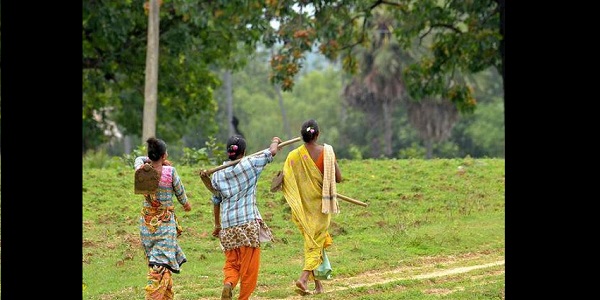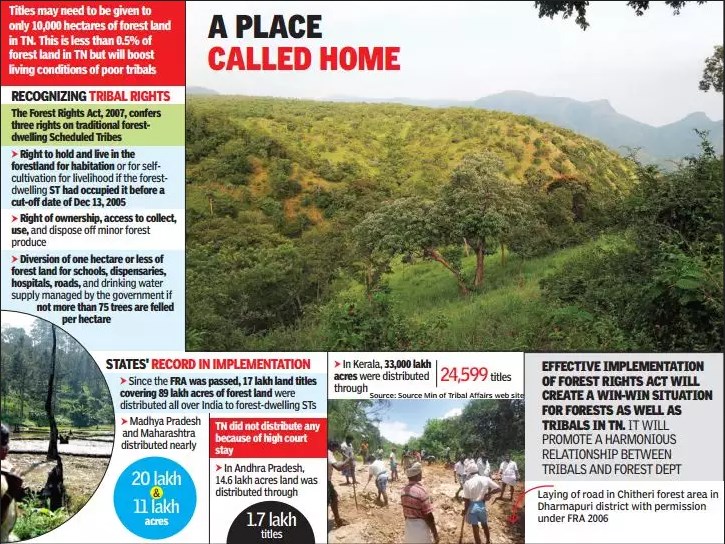Beyond Forest Rights Act

From Current Affairs Notes for UPSC » Editorials & In-depths » This topic
IAS EXPRESS Vs UPSC Prelims 2024: 85+ questions reflected
What is FRA?
- In the pre-independence period, the Indian Forest Act was enacted in 1927 to establish the procedure for settling the question on forest rights. However, it failed to deliver and left the forest dwelling communities in a state of tenurial insecurity and marginalization.
- The symbiosis between these communities and the forest was recognized, only later, by the 1988 National Forest Policy.
- The Scheduled Tribes and Other Traditional Forest Dwellers (Recognition of Forest Rights) Act is a legislation recognizing the rights of tribes and other forest-dwelling communities to the forest resources and to balance the right to environment with the right to life and livelihood. It was enacted in 2006.
- Its implementation process has democratic tenets:
- It requires the formation of a Forest Rights Committee in the 1st stage. This committee is composed of the village members selected by the Gram Sabha (with 2/3rd members present).
- It recognizes the role of women in forest economy and provides for equal rights in titles issued under it. They have been given an equitable role in decision-making.
What is its current status?
- The FRA has been in existence for 15 years now.
- As of April 2020, the Tribal Affairs Ministry had received some 42,50,602 claims. Of these, titles have been distributed to 46% of the applicants.
- Evidence show that the FRA implementation was better in areas close to urban settlements and in areas with better accessibility. Many central and state government programs such as the PM Gram Sadak Yojana, Deendayal Upadhyaya Gram Jyoti Yojana, MGNREGS, Janani Shishu Suraksha Karyakram, National Health Mission, National Food Security Act, etc. were implemented. This empowered the forest dwellers to assert their position.
- According to the forest department, the implementation is more or less completed.
- However, tribal rights activists allege that the forest department has overlooked many genuine claims of the forest dwellers.
What are the shortcomings?
- The FRA’s provision for the constitution of the Forest Rights Committee haven’t been followed in many places. These committees are often constituted by Panchayat Secretaries at short notice and upon the District Magistrates’ directives.
- There was opacity in the nomination of members for the committees at taluk- and district- levels.
- Women are barely included in the different stages of decision making.
- Initially, the insistence on satellite images as evidence and rejection of other admissible proofs led to the rejection of many claims. This happened in Gujarat. The matter had to be revisited after civil society filed a writ petition in 2011.
- There have been cases of the plot claims not matching with the documents that confirmed the award. This particularly happened in the villages near Bastar (Chhattisgarh).
- In several cases, the extent of land awarded was much smaller than the land claimed within the ceiling. The claimants didn’t protest against this, fearing that what little was given could be taken back by the authorities.
- The centre had directed that the tribal people be treated on par with others with regards to the many welfare schemes and development schemes of the rural department. However, these weren’t extended everywhere to reach these people who received the land possession documents under FRA.
- The poor awareness among the forest dwellers have added a handicap to the implementation process, especially in the remotely located scheduled areas.
- The scourge of insurgency in interior areas of states like Chhattisgarh has kept out the NGOs, which could have addressed this awareness deficit.
Other issues adding to the problem:
- In addition to this, many tribal areas are facing a deterioration in the forest produce’s quality. This has forced the dwellers to search for alternative sources of livelihood. In Chhattisgarh’s villages, earnings from collection of tendu leaves (for cigar making) saw a drop with the influx of workers from Bihar.
- This is added to by the poor market conditions and the exploitation of the forest dwellers by traders and middlemen.
- Though the recognition under FRA gave a psychological boost to the tribes, the lands possessed by them are often small and of low fertility, especially in the hilly region. Given the lack of irrigation facilities, these lands can only be put under rain-fed agriculture.
- The decline in income is forcing them to migrate in search of better paying work. Considering the low quality of education received by the tribal youth, their job prospects remain slim. They are finding employment as construction workers and road-laying laborers.
What is the way ahead?
- For the forest dwellers to effectively present their claims, they need a proper understanding of the FRA and its implementation process. NGOs, such as those in Gujarat’s Dang district, have been making a difference by aiding the claimants at every step. NGOs are vital for awareness generation and they must be supported to expand their presence even in the remoter areas.
- To improve the dwellers’ incomes and livelihoods, horticultural practices could be promoted. For example, bamboo and aloe vera cultivation could be encouraged, considering the presence of an assured market.
- Medical tourism and ecotourism could be promoted- along the lines of Kerala model.
- Skill-based education should be provided in these areas to improve the youth’s job prospects.
- A significant proportion of the tribal community are landless and suffer in poverty. They are engaged in small-scale agriculture, pastoralism and nomadic herding- occupations with low returns. Even on the Human Development Index, states with significant tribal population always rank below the national average.
- The FRA was never a panacea to address all the problems plaguing the tribes. However, it is important for improving their conditions, especially in the remoter areas.
- Their development depends on the implementation of existing schemes, programs and protective laws like the PESA (Panchayats (Extension to Scheduled Areas) Act, 1996). It is only a matter of will.
Conclusion:
The FRA is significant for recognizing the link between the forest dwellers and the forests. While the forest department holds that the FRA process is pretty much complete, tribal rights activists hold that many genuine claims have been overlooked. Going forth, the existing programs for these marginalized people need to be implemented in letter and spirit to truly realize the full objectives of FRA.
If you like this post, please share your feedback in the comments section below so that we will upload more posts like this.


